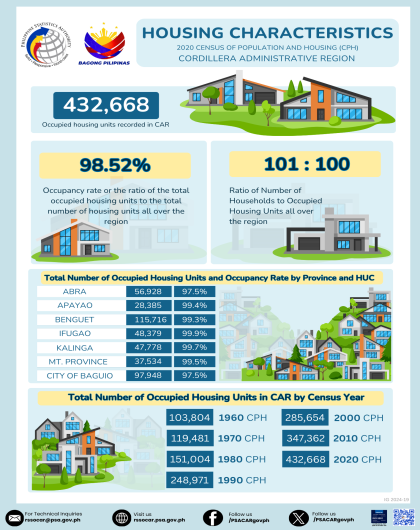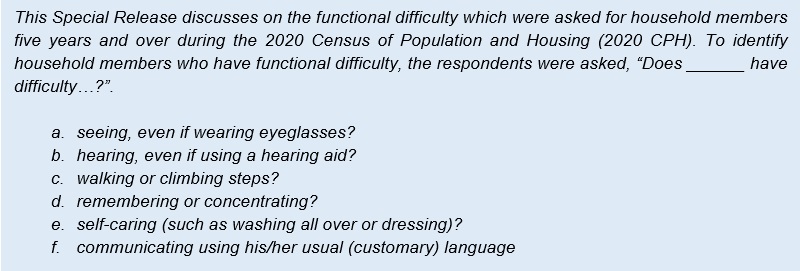
Functional difficulty in CAR slightly higher than national
- The functional difficulty, for the purpose of 2020 CPH, is classified into six (6) core functional domains or categories, that is, (a) seeing (even if wearing eyeglasses),
(b) hearing (even if using a hearing aid), (c) walking or climbing steps, (d) remembering or concentrating, (e) self-caring (such as washing all over or dressing), and (f) communicating using his/her usual (customary) language.
- The results of the 2020 CPH showed that a total of 150,757 persons or 9.2 percent of the total household population aged five (5) years old and over in the Cordillera Administrative Region (CAR) had at least one domain or category of functional difficulty regardless of severity. This was 0.5 percentage point higher than the national level with 8.7 percent.
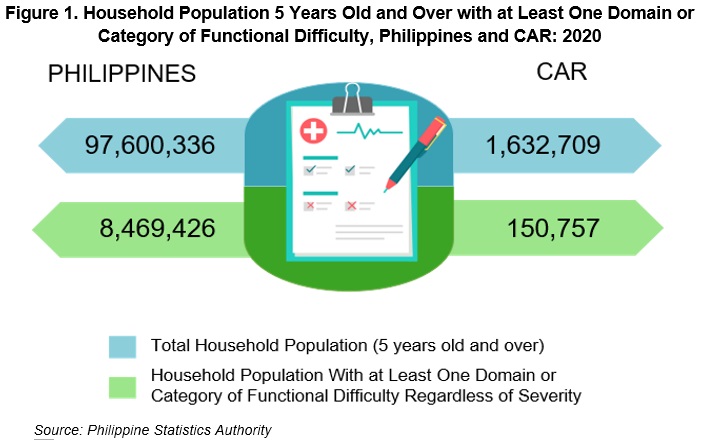
- Of the 150, 757 persons with at least one domain or category of functional difficulty in the region, 55.1 percent (83,094 persons) were females, while the remaining 44.9 percent (67,663 persons) were males.
- By sex ratio, 122 females for every 100 males have at least one domain or category of functional difficulty in the region.
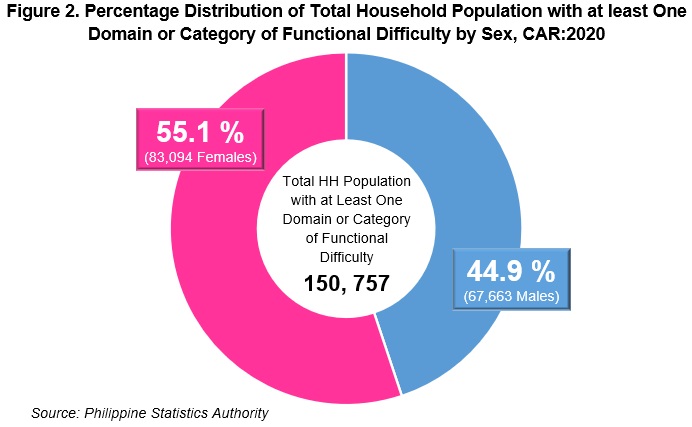
Age group 60 to 64 years old has highest number of household population with at least one domain or category of functional difficulty
- By age group, the household population aged 60 to 64 years old had the most number of household population with at least one domain or category of functional difficulty with 18,180 persons (12.1 percent). This was followed by age groups 55 to 59 years old and 65 to 69 years old with 16,398 persons (10.9 percent) and 16, 139 persons (10.7 percent), respectively.
- Of the household population aged 60 to 64 years old, 52.0 percent were females while the remaining 48.0 percent were males. These were translated to 9,447 and 8,733 persons, respectively.
- On the other hand, the youngest age group, 5 to 9 years old, had the least number of household population with at least one domain or category of functional difficulty with
2, 037 persons (1.4 percent).
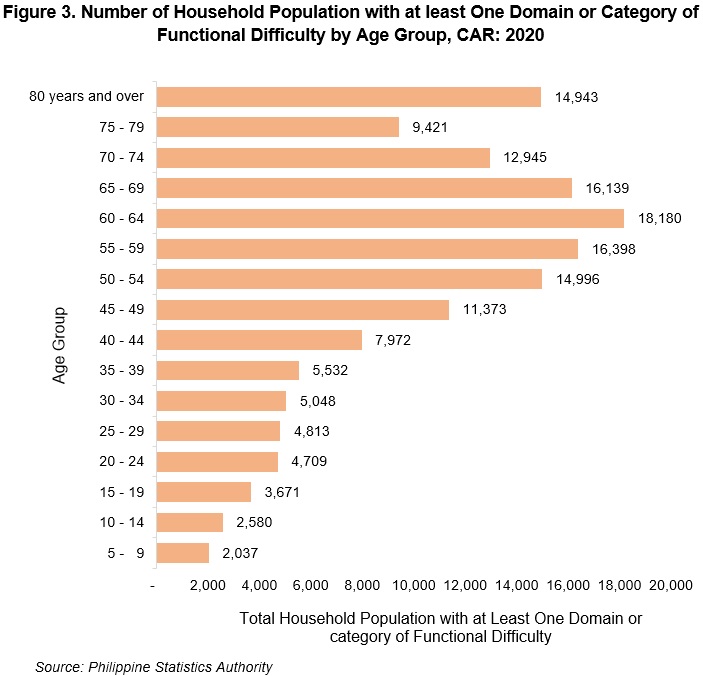
Majority of household population with functional difficulty have mild level of severity
- By level of severity, 125,350 persons (83.1 percent) of the total household population aged 5 years old and over with functional difficulty in the region had mild functional difficulty.
- This was followed by moderate functional difficulty with 18,411 persons
(12.2 percent).
- Meanwhile, a total of 6, 996 persons (4.6 percent) had severe functional difficulty.
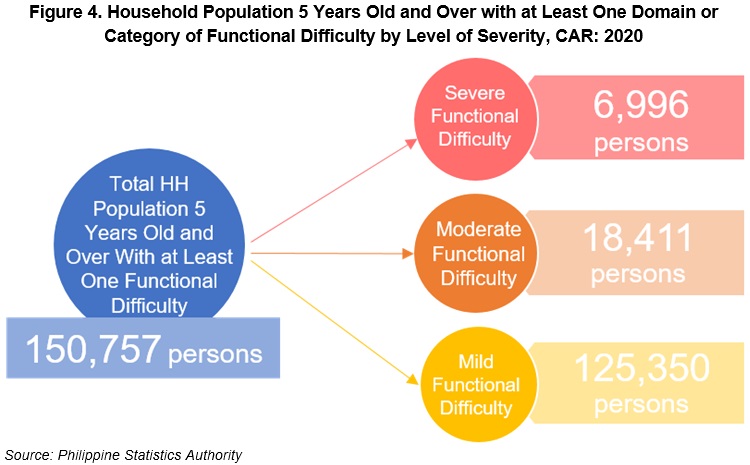
Difficulty in seeing, even when wearing glasses is most common domain of functional difficulty
- Of the 150,757 household population aged 5 years old and over with functional difficulty, 103,726 persons had difficulty in seeing, even when wearing glasses. This was followed by difficulty in walking or climbing steps with 45,033 persons and difficulty in hearing, even when using a hearing aid with 42,201 persons, respectively.
- Mild cases had the highest number in terms of level of severity in all domain of functional difficulty. Among mild cases, 94,626 persons had difficulty in seeing, even when wearing glasses, 35,401 persons had difficulty in hearing, even when using a hearing aid, and 35,004 persons had difficulty in walking or climbing steps.
- Difficulty in seeing, even when wearing glasses had the highest cases among moderate cases with 7,733 cases.
- On the other hand, difficulty in self-caring (washing all over or dressing) had the highest among severe cases with 3,439 cases.
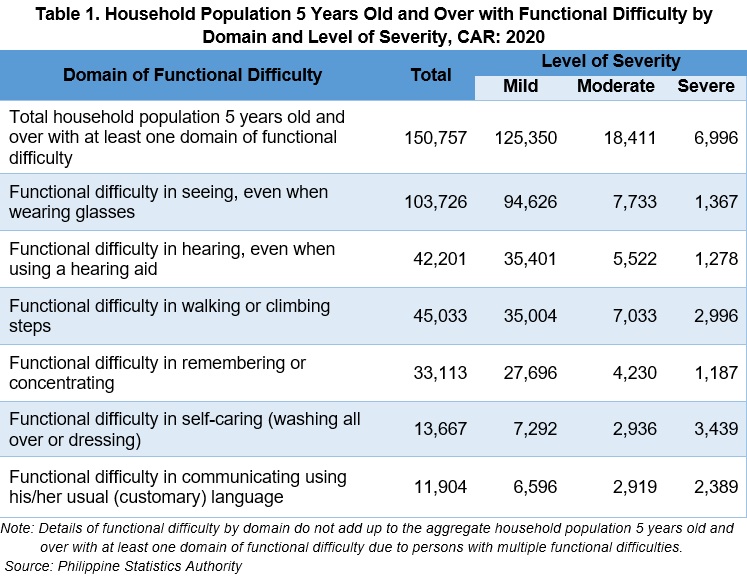
--- TECHNICAL NOTES ---
Functional difficulty, for the purpose of 2020 CPH, is classified into six (6) core functional domains or categories, that is, a.) seeing (even if wearing eyeglasses), b.) hearing (even if using a hearing aid), c.) walking or climbing steps, d.) remembering or concentrating, e.) self-caring (such as washing all over or dressing), and f.) communicating using his/her usual (customary) language.
Household is a social unit consisting of a person or a group of persons who sleep in the same housing unit and have a common arrangement in preparing and consuming food.
Household population refers to all persons who are members of the household.
Sex is the biological and physiological reality of being a male or female.
Age refers to interval of time between the person’s date of birth and his/her last birthday prior to the census reference date. It is expressed in completed years or whole number.


